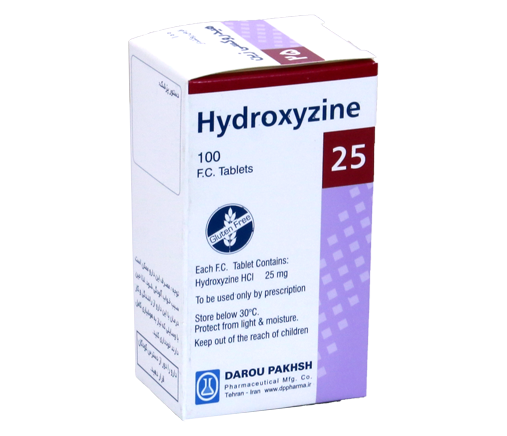Hydroxyzine (As Hydrochloride)
- Hydroxyzine (As Hydrochloride)
- No Brand Name
- Tablet
- 25mg
- Blister
- 100 Tablets
-
• Anxiety
• Pruritus
• Pruritus
Mechanism of Action
H1-receptor antagonist with low to moderate antihistaminic properties, inhibits respiratory, vascular, and GI smooth-muscle constriction
Moderate to high anticholinergic and antiemetic properties
Pharmacokinetics
Onset: 15-30 min
Excretion: Urine
Contraindications
• Documented hypersensitivity or related product including cetirizine and levocetirizine and components of the formulation
• Prolonged QT interval
Adverse Reactions
Dry mouth, Drowsiness, Involuntary motor activity
Major Drug Interactions
Dronedarone - Thioridazine
Warnings
• May cause oversedation and confusion in elderly patients, start on lower doses and monitor closely
• Use caution in patients with narrow-angle glaucoma, prostatic hyperplasia, or respiratory disease (asthma or COPD)
Recommendations for Patient
• May cause CNS depression resulting in drowsiness, avoid driving or operating dangerous machinery
Pregnancy Considerations
Considered to be contraindicated in early (1st trimester) pregnancy until more human pregnancy data available, current limited data suggests that the drug does not represent a significant risk of developmental toxicity at any time in pregnancy.
Breastfeeding Considerations
Excretion in milk unknown, use with caution
Pregnancy Categories
A: Generally acceptable. Controlled studies in pregnant women show no evidence of fetal risk.
B: Maybe acceptable. Either animal studies show no risk but human studies not available or animal studies showed minor risks and human studies done and showed no risk.
C: Use with caution if benefits outweigh risks. Animal studies show risk and human studies not available or neither animal nor human studies done.
D: Use in LIFE-THREATENING emergencies when no safer drug available. Positive evidence of human fetal risk.
X: Do not use in pregnancy. Risks involved outweigh potential benefits. Safer alternatives exist.
NA: Information not available.

H1-receptor antagonist with low to moderate antihistaminic properties, inhibits respiratory, vascular, and GI smooth-muscle constriction
Moderate to high anticholinergic and antiemetic properties
Pharmacokinetics
Onset: 15-30 min
Excretion: Urine
Contraindications
• Documented hypersensitivity or related product including cetirizine and levocetirizine and components of the formulation
• Prolonged QT interval
Adverse Reactions
Dry mouth, Drowsiness, Involuntary motor activity
Major Drug Interactions
Dronedarone - Thioridazine
Warnings
• May cause oversedation and confusion in elderly patients, start on lower doses and monitor closely
• Use caution in patients with narrow-angle glaucoma, prostatic hyperplasia, or respiratory disease (asthma or COPD)
Recommendations for Patient
• May cause CNS depression resulting in drowsiness, avoid driving or operating dangerous machinery
Pregnancy Considerations
Considered to be contraindicated in early (1st trimester) pregnancy until more human pregnancy data available, current limited data suggests that the drug does not represent a significant risk of developmental toxicity at any time in pregnancy.
Breastfeeding Considerations
Excretion in milk unknown, use with caution
Pregnancy Categories
A: Generally acceptable. Controlled studies in pregnant women show no evidence of fetal risk.
B: Maybe acceptable. Either animal studies show no risk but human studies not available or animal studies showed minor risks and human studies done and showed no risk.
C: Use with caution if benefits outweigh risks. Animal studies show risk and human studies not available or neither animal nor human studies done.
D: Use in LIFE-THREATENING emergencies when no safer drug available. Positive evidence of human fetal risk.
X: Do not use in pregnancy. Risks involved outweigh potential benefits. Safer alternatives exist.
NA: Information not available.
Send to other people



